The design of a home office can significantly impact productivity, focus, and overall well-being. Color psychology—the study of how colors influence emotions, cognition, and behavior—plays a crucial role in creating a workspace that fosters a positive and productive environment.
In the context of home office design, understanding the nuances of color psychology allows you to personalize your space and optimize it for your specific needs and work style.
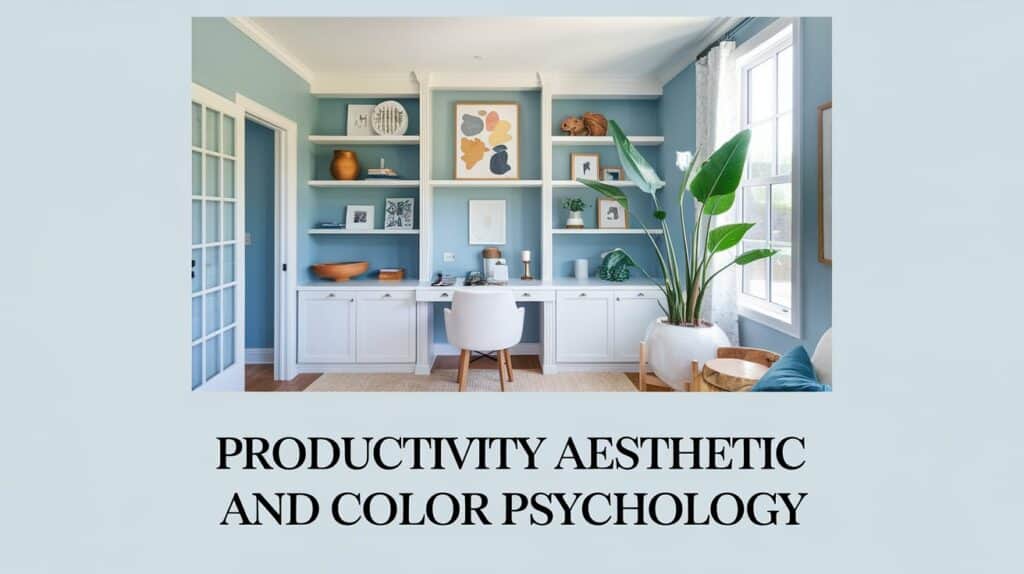
Colors like blue, known for their calming and tranquil effect, can transform your home office into a haven of concentration. Imagine a serene blue accent wall behind your desk, promoting focus and clarity during work sessions.
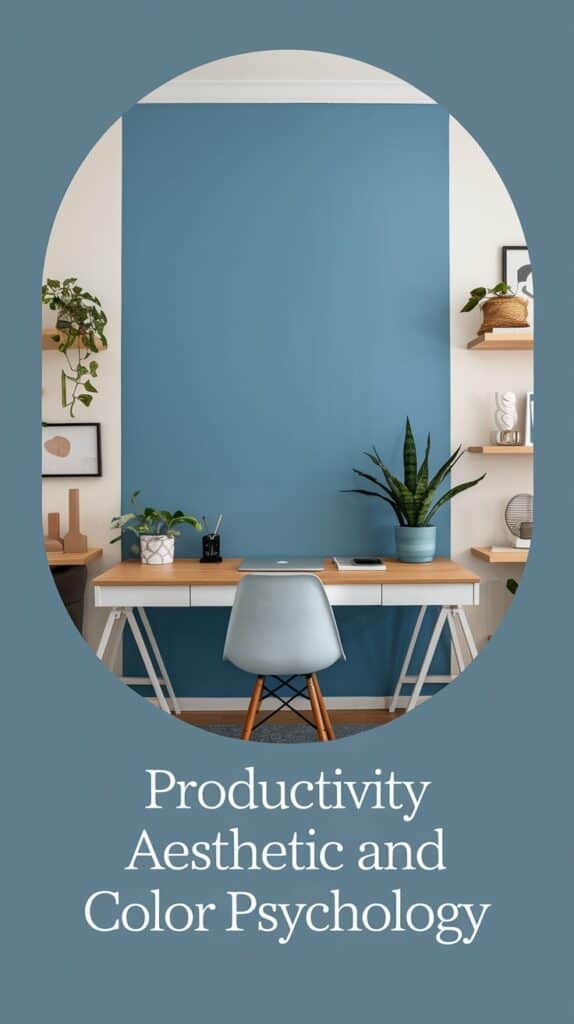
Conversely, red, a vibrant and energizing color, can be strategically used in areas where you need a boost of creativity or motivation. Consider incorporating red through artwork or accessories in your brainstorming corner.
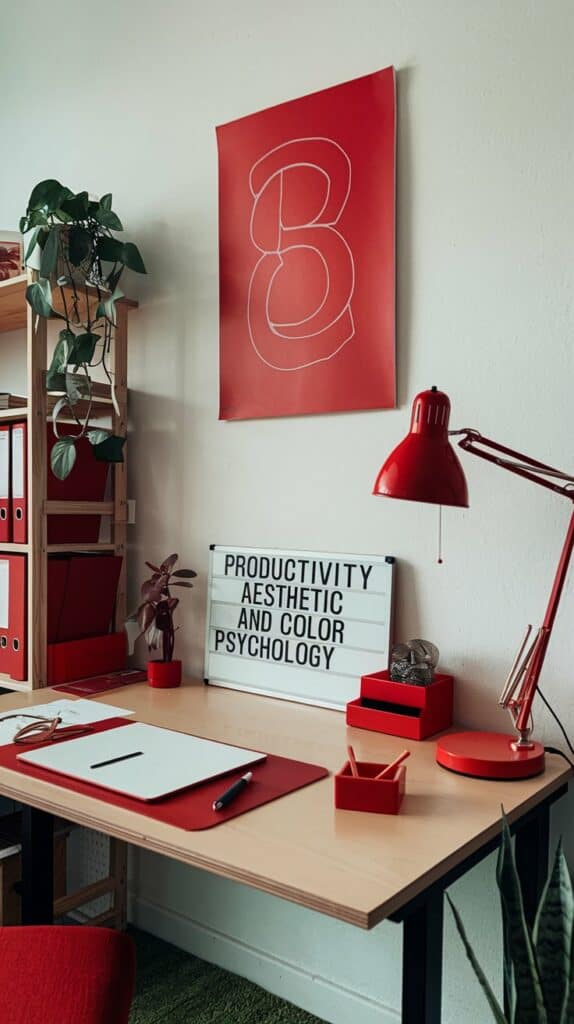
Green, associated with nature and tranquility, can enhance well-being and create a sense of calm in your home office. Introduce green through plants, artwork, or even a green throw blanket draped over your chair.
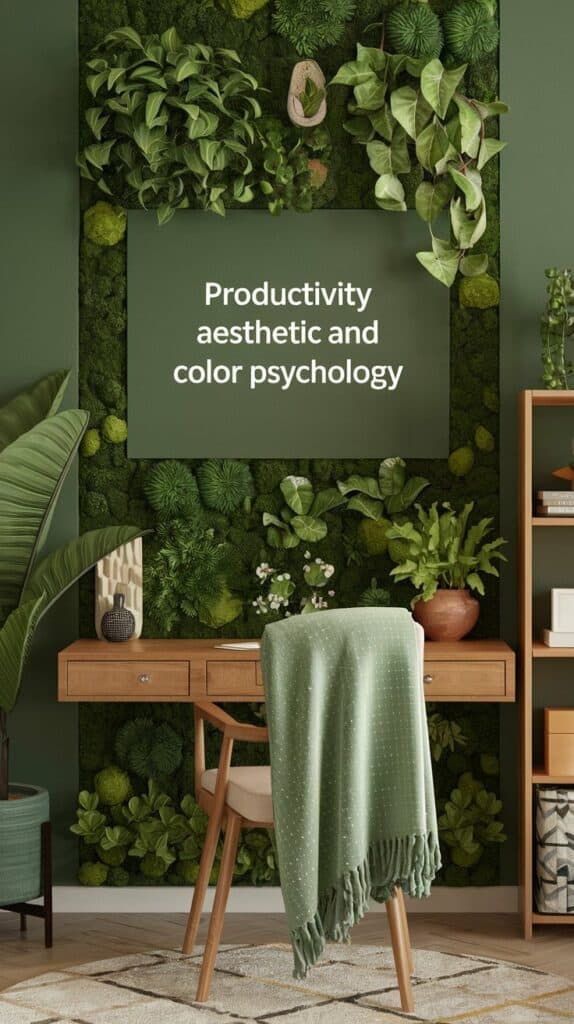
Neutral tones like grays and whites offer a versatile and elegant foundation for your home office design. They create a sense of spaciousness and allow you to personalize your space with colorful accents.
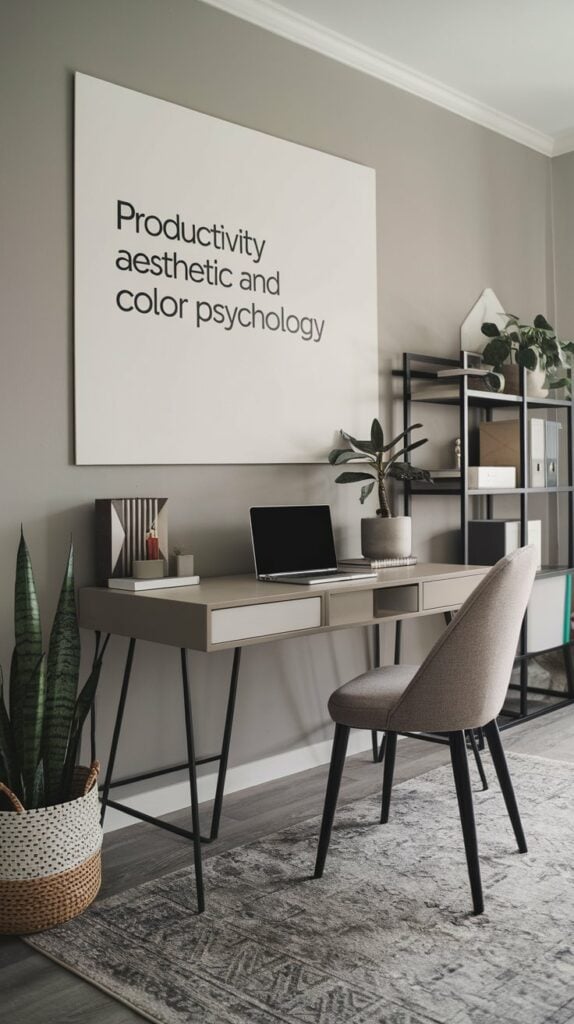
Yellow, linked to positivity and optimism, can be used in areas where you welcome guests or engage in creative activities. Consider a yellow lampshade or a vibrant piece of artwork to infuse your workspace with warmth and energy.
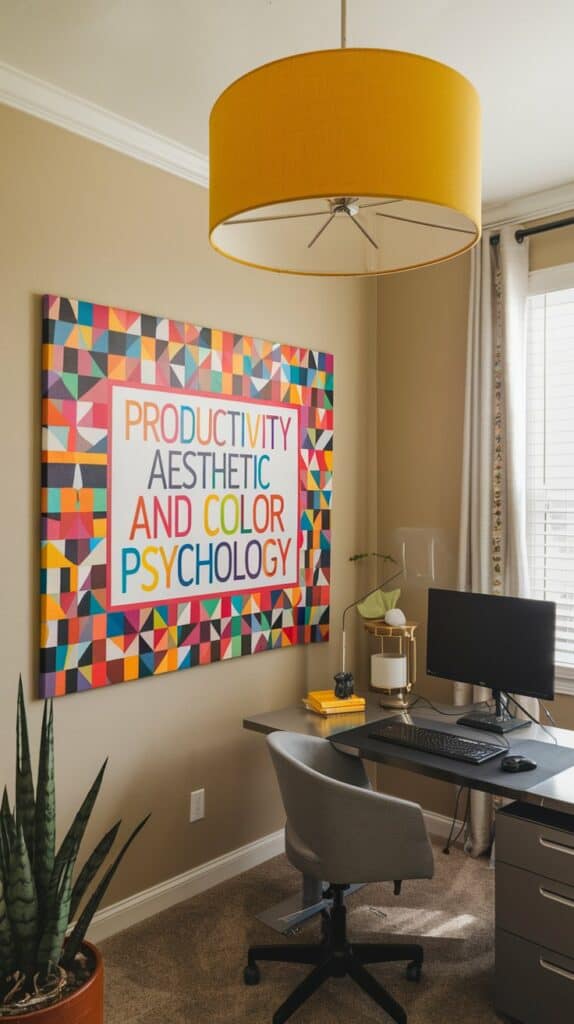
By leveraging the psychological effects of color, small businesses can optimize their workspace for improved efficiency and employee satisfaction. This article delves into the science behind color perception and processing, exploring how the strategic use of warm and cool hues can shape workplace dynamics, focus, and productivity.
Additionally, we'll examine the principles of the “productivity aesthetic” – the thoughtful integration of color, light, natural elements, and decor to create harmonious and inspiring work environments.
Understanding Color Psychology in the Office
The influence of color psychology in the home office is rooted in the profound impact of color on the human mind. Colors can shape our psychological responses, affecting emotions, behaviors, and even physiological reactions. Understanding this dynamic interplay between color and psychology is crucial for creating a home workspace that enhances mood, productivity, and overall well-being.
The Role of Color in Human Psychology
Warm colors like red and orange are often associated with energy, excitement, and passion, while cool colors like blue and green are linked to calmness, focus, and relaxation. These psychological associations can significantly impact the way we perceive and interact with our surroundings, including the home office design.
Impact on Emotional and Physical Well-being
The impact of color on well-being in your home office is significant, influencing stress levels, creative expression, and overall productivity. Studies have shown that the strategic use of color can create an inviting and comfortable workspace that enhances mood and efficiency.
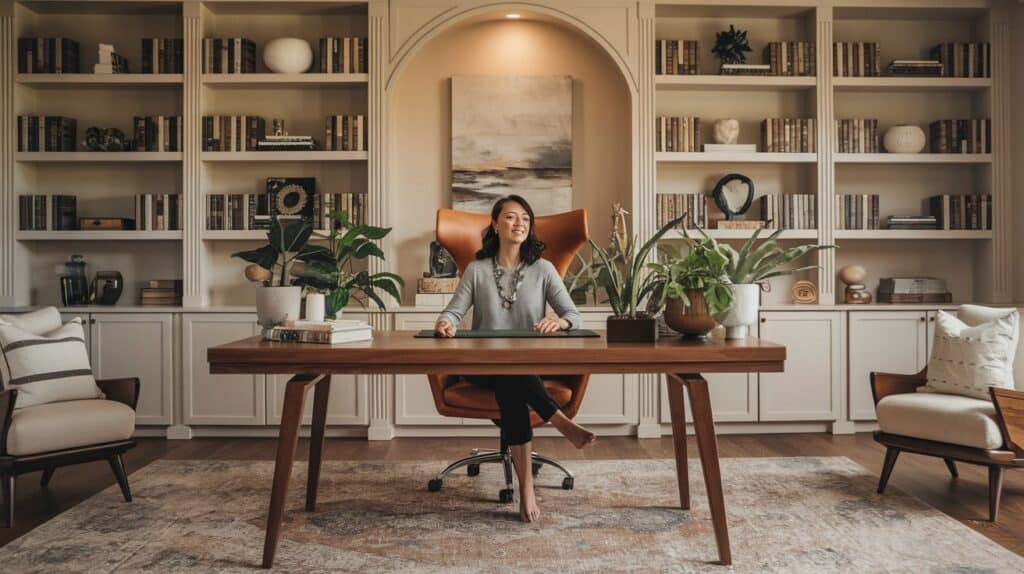
For instance, incorporating natural elements like plants and using soothing color palettes can contribute to a more harmonious and rejuvenating home office environment. Imagine a workspace with calming blues and greens, accented by the vibrant green of indoor plants. This combination can create a sense of tranquility and promote a more focused and productive work experience.
“Colors can have a profound impact on our mood, productivity, and overall well-being in the workplace.”
By understanding color theory and its influence on human psychology, you can create a home office space that fosters a positive and nurturing environment, ultimately leading to enhanced mood, productivity, and personal well-being.
Imagine your home office as a sanctuary that reflects your personality and supports your work style. With the thoughtful application of color, you can transform your workspace into an environment that inspires creativity, promotes focus, and enhances your overall productivity.
The Science Behind Color Perception and Processing
The way we perceive and process color is a fascinating journey that begins in our eyes and culminates in our brain, shaping our emotions and cognitive responses along the way!
Imagine light entering your eye and hitting the retina, where specialized cells called cones act like tiny receptors, each tuned to a different wavelength of light. These cones are the key to our ability to perceive the vibrant spectrum of colors around us.
From the retina, this color information travels to the visual cortex, a specialized area in the brain that acts like a central processing unit. Here, the complex task of interpreting and processing this visual data takes place. The visual cortex analyzes the color signals, integrating them with other sensory inputs to create the rich tapestry of colors that we experience.
But this brain processing of color is more than just a passive reception of information. It actively shapes our emotional and cognitive responses. Certain colors can evoke specific feelings, influence our moods, and even impact our decision-making. For example, imagine the calming effect of blue or the invigorating energy of red.
Understanding this intricate relationship between color and the human psyche is crucial for effectively applying color psychology in your home office design. By thoughtfully incorporating colors that inspire, motivate, and promote well-being, you can create a workspace that truly supports your productivity and enhances your work experience.
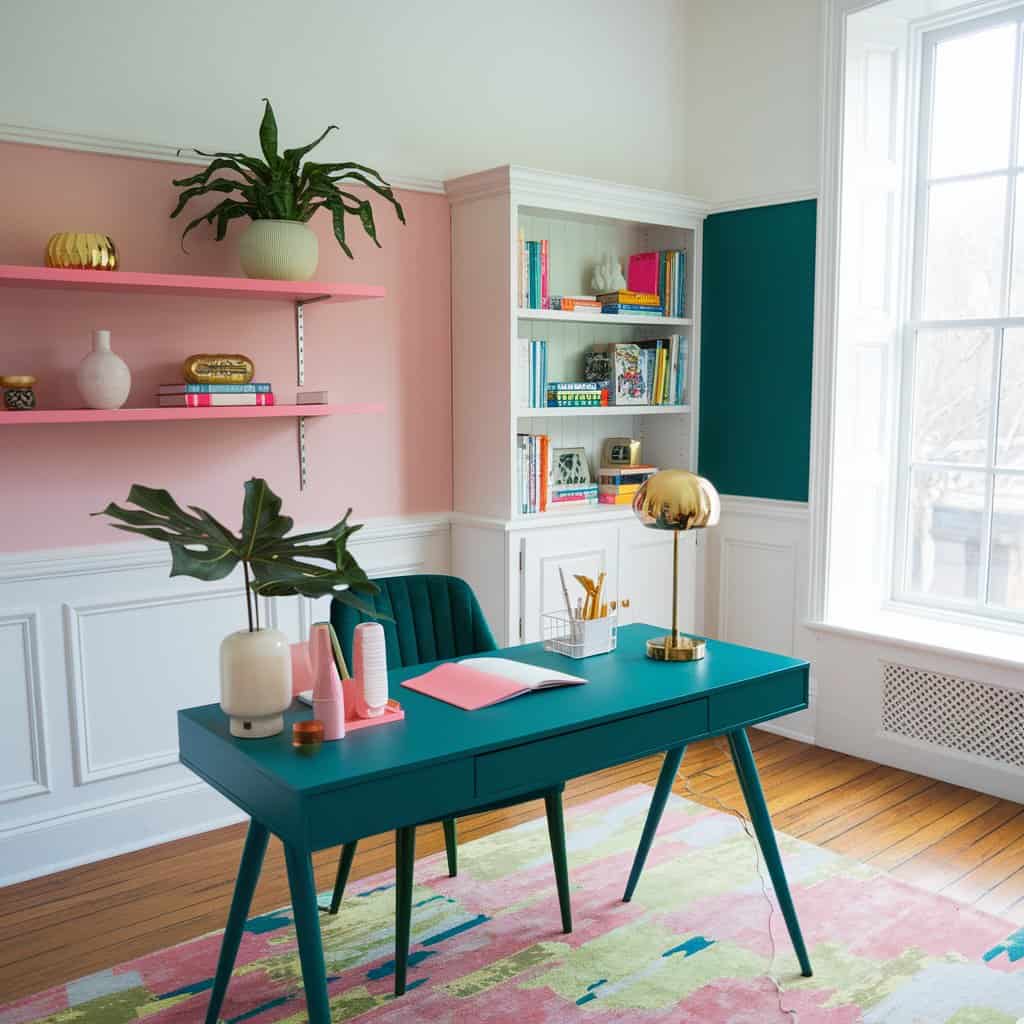
By harnessing the power of color, we can create home office environments that inspire, energize, and promote productivity. Whether it's the calming influence of cool tones like blues and greens, or the stimulating effect of warm hues like reds and yellows, the strategic use of color can have a profound impact on our overall well-being and performance in our home workspace.
Imagine a home office where the colors work in harmony with your needs and personality. Perhaps a calming blue wall promotes concentration in your main workspace, while a splash of energizing red in a corner dedicated to brainstorming ignites your creativity. By thoughtfully curating the colors in your home office, you can create an environment that truly supports your productivity and enhances your work-life balance.
Warm Colors and Their Impact on Work Dynamics
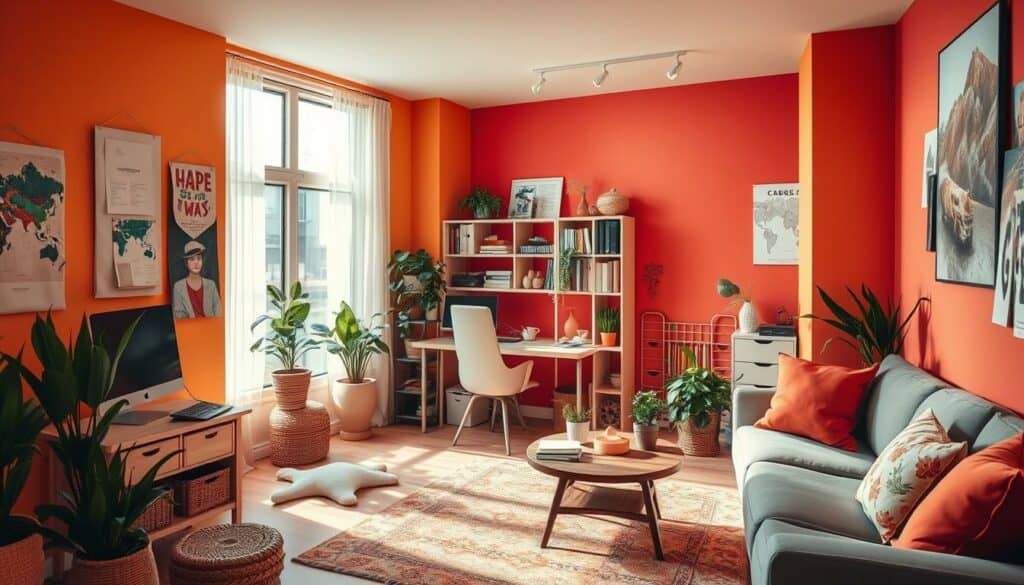
Warm colors, encompassing shades like red, orange, and yellow, are known for their stimulating and energizing effects. In the context of a home office, these colors can be strategically used to evoke specific moods and behaviors.
Red, the most intense of the warm colors, is associated with passion, energy, and excitement. While it might be overwhelming as the dominant color in a home office, it can be used strategically to accentuate specific areas. For instance, a red accent wall in a brainstorming corner could stimulate creativity and inspire innovative thinking.
Orange, a vibrant and cheerful color, promotes enthusiasm and creativity. It can be incorporated into a home office through artwork, accessories, or even a statement piece of furniture. Orange can help create a welcoming and energetic atmosphere, particularly beneficial for those who work from home and need a boost of motivation.
Yellow, the color of sunshine, is associated with optimism, happiness, and intellectual energy. It can be a great choice for a home office, especially in spaces dedicated to learning or creative tasks. However, it's important to use yellow in moderation, as an overabundance can be overstimulating and lead to anxiety.
When incorporating warm colors into your home office, consider the following:
- Balance: Pair warm colors with cooler tones or neutrals to create a harmonious balance and prevent the space from feeling overwhelming.
- Lighting: Warm colors can be enhanced by natural light, making them a great choice for home offices with ample windows.
- Personal preferences: Choose warm colors that resonate with your personality and work style.
By thoughtfully integrating warm colors into your home office design, you can create an environment that sparks creativity, fosters enthusiasm, and promotes productivity.
Cool Colors for Focus and Productivity
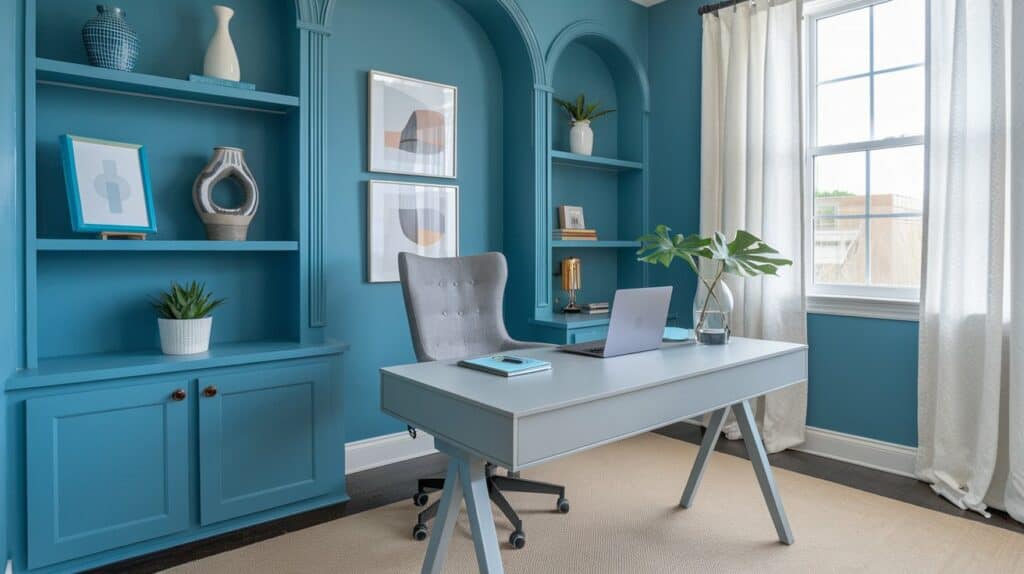
When it comes to creating a productive and focused home office environment, the strategic use of cool colors can make all the difference. Colors like blue, green, and purple have been shown to have a positive impact on concentration and efficiency.
Soothing blue evokes feelings of calmness and stability, making it ideal for detail-oriented tasks that require deep focus. Imagine a home office with a serene blue accent wall, promoting a sense of tranquility and reducing eye strain. Shades like Behr Aloe Thorn, Magnolia Eden, and Benjamin Moore Blue Hydrangea can help create this calming atmosphere.
Rejuvenating green symbolizes balance and growth, stimulating creativity and problem-solving. Incorporating green into your home office through plants, artwork, or even a green throw blanket can inspire innovative thinking and reduce stress levels. Consider hues like Clare Daily Greens, Valspar Organic Garden, and Behr Secret Meadow to bring the calming essence of nature into your workspace.
Touches of purple can inject a touch of imagination and innovation into your home office. Purple accents, such as artwork or accessories in shades like Sherwin-Williams Mature Grape, Backdrop Lobby Scene, and Magnolia Plum Suede, can help cultivate a sense of uniqueness and individuality.
By incorporating these cool colors into your home office design, you can create a serene and focused environment that supports concentration and boosts overall productivity. The right balance of blue, green, and purple can lead to improved performance, reduced stress levels, and a greater sense of well-being in your personal workspace.
Productivity Aesthetic: Designing the Ideal Workspace
Crafting the perfect home workspace is an art form that goes beyond mere aesthetics. It involves a delicate balance of color, light, and natural elements to create an environment that not only looks visually appealing but also boosts productivity and well-being. By understanding the science behind home office layout, natural lighting, biophilic design, and ergonomic furniture, you can curate a workspace that truly empowers you to thrive.
Consider these elements when designing your home office:
- Color Psychology: As we've discussed, the colors you choose can significantly impact your mood, focus, and creativity. Select a palette that aligns with your work style and personality.
- Natural Lighting: Maximize natural light by positioning your desk near a window. Natural light has been shown to improve mood, reduce eye strain, and increase productivity.
- Biophilic Design: Incorporate elements of nature into your workspace, such as plants, natural materials, and views of the outdoors. This can reduce stress, enhance creativity, and promote a sense of well-being.
- Ergonomic Furniture: Invest in a comfortable and supportive chair, an adjustable desk, and other ergonomic accessories to ensure proper posture and reduce the risk of discomfort or injury.
- Office Layout: Arrange your workspace to minimize distractions and maximize efficiency. Consider the placement of your desk, storage solutions, and technology to create a smooth workflow.
By thoughtfully considering these elements, you can create a home office that is both functional and inspiring, a space where you can truly thrive and do your best work.
Balance of Color and Light
The choice of colors and lighting in a home office can significantly impact mood, focus, and creativity!
Research suggests that blue and green color schemes can indeed lead to increased productivity and creativity. These cool colors evoke feelings of calmness and tranquility, promoting concentration and a sense of well-being.
On the other hand, white-colored workspaces, while seemingly clean and minimalist, can actually decrease overall productivity. This is because white can be stark and sterile, lacking the visual stimulation that our brains need to stay engaged and focused.
Natural lighting plays a crucial role in home office design. Positioning your workspace near a window to maximize natural light can improve mood, reduce eye strain, and increase productivity.
Complementing natural light with strategically placed artificial light sources can further enhance the functionality and aesthetics of your space. Consider a combination of ambient lighting, task lighting, and accent lighting to create a well-lit and inviting environment.
Here are some additional tips for optimizing lighting in your home office:
- Avoid harsh fluorescent lighting: Opt for softer, warmer light sources that mimic natural light.
- Use adjustable lighting: Choose lamps with adjustable brightness and color temperature to customize the lighting according to your needs throughout the day.
- Consider the placement of light sources: Position lamps to avoid glare on your computer screen and to provide adequate illumination for your work surface.
By thoughtfully incorporating color and lighting into your home office design, you can create a workspace that supports your productivity, enhances your well-being, and inspires you to do your best work.
Incorporating Natural Elements
Biophilic design is a powerful tool for enhancing well-being and productivity in the home office. By incorporating elements of nature into your workspace, you can create a more calming, restorative, and inspiring environment.
Here are some ways to integrate biophilic design principles into your home office:
- Introduce plants: Plants not only add visual appeal but also purify the air, reduce stress, and boost creativity. Choose a variety of plants with different textures and colors to create a vibrant and stimulating environment.
- Maximize natural light: As we discussed earlier, natural light is crucial for well-being and productivity. Position your desk near a window to maximize exposure to sunlight.
- Incorporate natural materials: Use natural materials like wood, bamboo, and stone in your furniture and décor. These materials create a sense of warmth and connection to the natural world.
- Introduce water features: The sound of running water can be incredibly soothing and promote relaxation. Consider adding a small fountain or aquarium to your home office.
- Create a view of nature: If possible, position your desk so you have a view of nature, such as a garden, trees, or the sky. Even a small glimpse of nature can have a restorative effect.
Studies have shown that employees exposed to natural light in the workplace report a 15% increase in overall well-being. This translates to the home office as well. By creating a biophilic workspace, you can improve your mood, reduce stress, and enhance your overall productivity and well-being.
Furniture and Decor Selection
Furniture and decor play a vital role in creating a productive and comfortable home office. Investing in ergonomic furniture that promotes good posture and minimizes physical strain is essential for your well-being and productivity.
Here's how to optimize your home office furniture and décor:
Ergonomic Furniture:
- Invest in an adjustable chair: Choose a chair with adjustable height, lumbar support, and armrests to ensure proper posture and reduce back pain.
- Consider a standing desk: Alternating between sitting and standing throughout the day can improve circulation, reduce fatigue, and boost productivity.
- Choose an ergonomic keyboard and mouse: These can help prevent carpal tunnel syndrome and other repetitive strain injuries.
- Position your monitor correctly: The top of your monitor should be at or slightly below eye level to reduce neck strain.
Décor and Personalization:
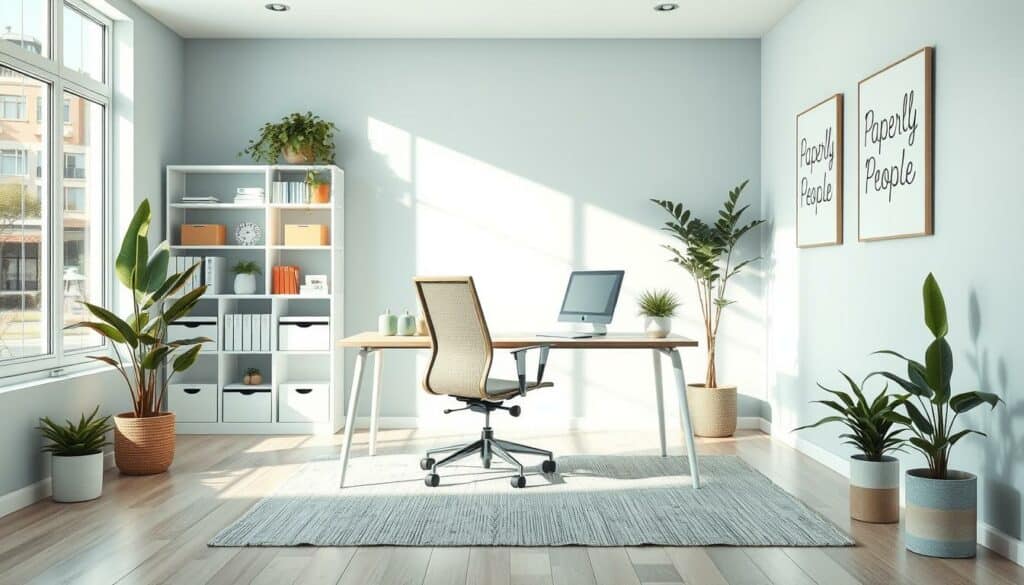
- Add personal touches: Surround yourself with things that inspire you, such as artwork, photos, and personal items. This can boost creativity and motivation.
- Incorporate plants: As mentioned earlier, plants have numerous benefits, including air purification, stress reduction, and improved mood.
- Minimize clutter: A cluttered workspace can be distracting and overwhelming. Keep your desk and surrounding area organized and tidy.
- Choose colors and patterns that inspire you: Select colors and patterns that you find visually appealing and that promote a sense of calm and focus.
By thoughtfully selecting furniture and décor that supports your physical comfort and inspires your creativity, you can create a home office that is both functional and aesthetically pleasing. This will not only boost your productivity but also enhance your overall well-being and enjoyment of your workspace.
Productivity Aesthetic and Color Psychology Wrapup
Creating a productive and inspiring home office is a multifaceted endeavor that involves thoughtfully considering color psychology, lighting, biophilic design, and ergonomic furniture. By understanding how these elements interact and influence your well-being and productivity, you can curate a workspace that truly supports your work style and enhances your work-life balance.
Remember, your home office is more than just a place to work; it's an extension of your home and a reflection of your personality. By investing time and effort into creating a space that is both functional and inspiring, you can transform your work experience and unlock your full potential!
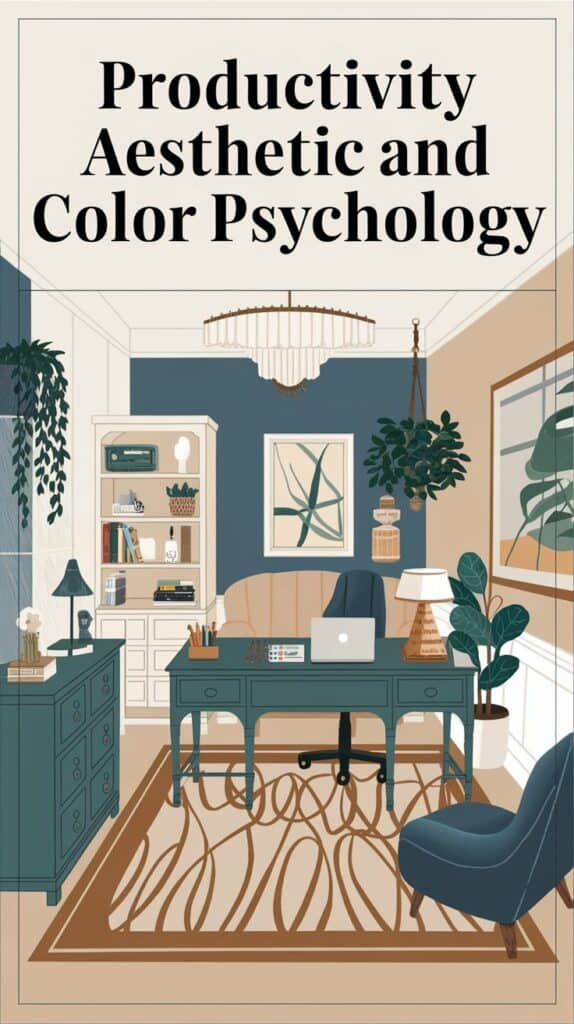
 Tara’s “tell it like it is” personality combined with her 100 miles per hour presentations have earned her the title “The Queen of Marketing Ahhh’s” from her raving fans. Check out her marketing courses and products at her Etsy Store,
Tara’s “tell it like it is” personality combined with her 100 miles per hour presentations have earned her the title “The Queen of Marketing Ahhh’s” from her raving fans. Check out her marketing courses and products at her Etsy Store,